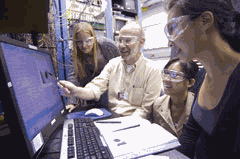Practitioners of the environmental sciences have traditionally been under-represented as users of x-ray spectromicroscopy tools. In a first step toward rectifying that situation, a two-week School for Environmental Sciences with Synchrotrons (SESS) was held at the APS on October 10-22, 2007. The APS is the only synchrotron radiation facility in the U.S. with a beamline that specializes in x-ray spectromicroscopy experiments in the intermediate energy (1-4 keV) range. The aim of the school was to introduce young scientists to the capabilities of the APS, under the tutelage of established environmental scientists. The hope is that initiatives such as this workshop will encourage the next generation of environmental scientists to begin their own research projects at the APS and other synchrotron facilities.
Workshop attendees were given training on the scanning x-ray microscope at X-ray Operations and Research beamline 2-ID-B at the APS. This instrument is one of the few in the world where spectral and spatial information can be obtained from samples with intermediate-energy x-rays, providing a unique opportunity to study chemical speciation of phosphorus, sulfur, and chlorine in specimens by x-ray near-edge absorption spectroscopy in combination with fluorescence mapping. These elements are of great interest to environmental scientists because of their prevalence and importance in such diverse systems as soils, marine sediments, and bio-geo-chemical interfaces.
Four respected researchers familiar with synchrotron radiation research brought teams of graduate students and postdoctoral fellows to the school. The groups learned about the principles of x-ray spectromicroscopy and carried out hands-on work on the 2-ID-B scanning x-ray microscope. The younger scientists brought their own samples, assuring that the experiments were relevant to their own work. John Coates's group, from the Department of Plant and Microbial Biology at the University of California, Berkeley, studied the fate of sulfur during reduction/reoxidation of humic substances and organic soil components, with the goal of comparing reduction pathways. Dean Hesterberg's group from the Department of Soil Science at North Carolina State University in Raleigh analyzed molecular mechanisms of phosphate retention and dissolution in organic matter and clay-organic systems. A group led by Johannes Lehmann from the College of Agriculture and Life Sciences at Cornell University aimed to understand mechanisms of stabilization of organic carbon in soil, namely the interactions between mineral and black carbon surfaces and microbial metabolites. Satish Myneni and his team from the Department of Geosciences at Princeton University studied phosphorus distribution and speciation in soil bacteria.
Concurrent with their experiments, the teams each gave seminars on their research to the APS community, contributing substantially to the breadth of the program. By the end of the school, all four groups planned to submit proposals for new experiments and to continue their research at the APS. Overall, SESS was a tremendous success in that it introduced several young scientists to the powerful capabilities of x-ray spectromicroscopy, gave them confidence to pursue their own research programs, and broadened understanding of environmental research at the APS. The organizers, Juergen Thieme (Institute for X-Ray Physics, University of Goettingen) and Ian McNulty (APS, Argonne), look forward to the next SESS school in 2008, and to introducing a new group of students to the exciting prospects for environmental x-ray spectromicroscopy.
Contact: Juergen Thieme ([email protected]), Ian McNulty ([email protected])
Reference: J. Thieme, I. McNulty, D. Paterson, S. Vogt, "X-ray Spectromicroscopy - A Tool for Environmental Sciences," Environ. Sci. Technol., 41, 6885 (2007).
The Advanced Photon Source is supported by the U. S. Department of Energy, Office of Science, Office of Basic Energy Sciences, under Contract No. DE-AC02-06CH11357. Argonne is a U.S. Department of Energy laboratory managed by UChicago Argonne, LLC.

